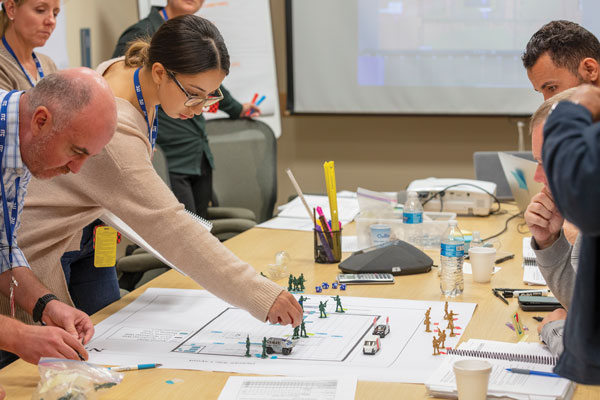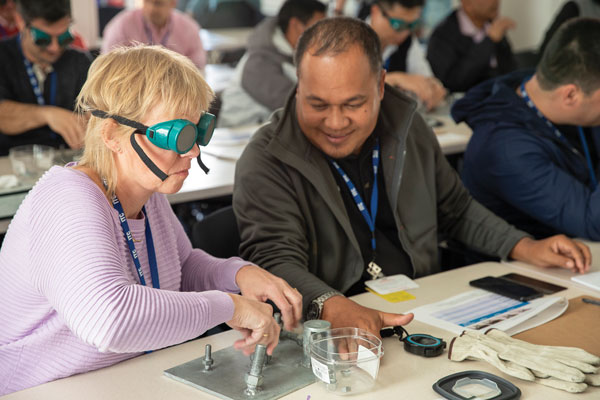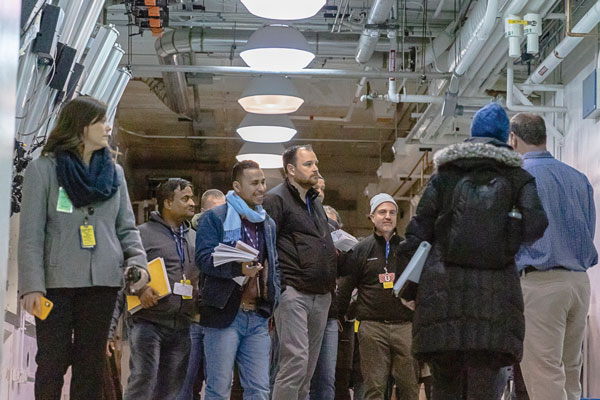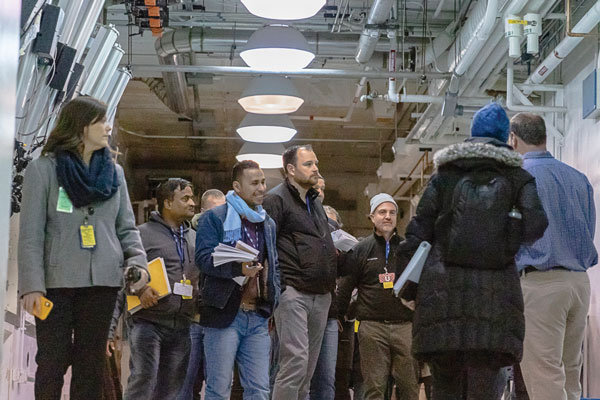
See below: Scribe3D brings tabletop exercises to life
The International Atomic Energy Agency and NNSA recently cohosted the 28th International Training Course on the Physical Protection of Nuclear Material and Nuclear Facilities at Sandia. The three-week session provided 59 participants from 40 countries with the knowledge and practical skills to effectively define, design and evaluate physical protection systems that guard against the unauthorized removal of nuclear materials and sabotage of nuclear facilities.

The course involves both classroom training and hands-on exercises. Some of these exercises are held at Sandia’s Integrated Security Facility, which was originally designed to protect nuclear material, but now serves as a venue for advanced training and in-depth testing and evaluation of security systems. With its fully functional security systems, ISF is invaluable for demonstrating the operational and technical elements required for effective physical security, including physical protection, nuclear materials accounting and controls, response, transport security, sabotage, insider threat, cybersecurity, drills and exercises and national-level infrastructure.
During the final week of the course, participants divided into subgroups to design a security system for one of three hypothetical nuclear facilities — a nuclear power plant, a nuclear material research reactor and a small modular reactor — and then tested that design with various evaluation tools. The subgroups also created adversary scenarios and conducted a tabletop exercise that included an attempted act of sabotage. For the first time, the subgroups used Scribe3D, a new software tool that documents the exercise and provides real-world context. The course concluded with international speakers from the IAEA and presentations from each of the subgroups on their findings.

Noting the long history of collaboration between the IAEA, NNSA and Sandia, Muhammad Khaliq, head of the Nuclear Security of Materials and Facilities section of the IAEA’s Division of Nuclear Security, said, “We continuously update the course materials to reflect the needs of the member states. This time, we have included new modules on security for small modular reactors and information about insider threats. The ITC continues to be our flagship course on physical security.”

Sandia ITC Director Gregory Baum said, “Our participants come from a wide variety of backgrounds — some work in operational areas at nuclear power plants or research reactors, some are regulators or policy makers. Beyond the training, ITC gives them the opportunity to form professional connections and build a stronger international community of practice.”
The ITC has been held every 18 months since 1978 and has provided training on international best practices for physical protection of nuclear material and nuclear facilities to more than 1,000 participants from more than 70 countries.
Scribe3D brings tabletop exercises to life
To test physical security systems at facilities that house nuclear materials, defenders visualize potential attacks and train to mitigate threats.
“Attacks can come from every possible direction — defense is not two-dimensional,” said Jordan Parks, Sandia’s Scribe3D team lead. “While tabletop exercises are an important tool for testing physical security designs, a three-dimensional model that coordinates multiple response factors in real time can reveal weaknesses not visible on paper.”
Developed to enhance the physical security curriculum established by Sandia’s international nuclear security engineering team for the International Atomic Energy Agency and NNSA, Scribe3D records tabletop exercises and plays back simulated videos of the scenarios and responses developed, which helps to direct operational discussions, capture results and visualize consequences. The software was designed to be used in countries with any technical maturity level and is fully exportable at no cost.
“Defenders can develop scenarios that test current defenses, then use the tool to look at how changes to procedures, facilities or technology might influence the outcome,” Jordan said. “It allows physical security forces at facilities worldwide to continuously improve their response to current and future threats.”
With multiple licensing agreements in process, Scribe3D has gained wide domestic and international acceptance. The tool is already being used by NNSA International Nuclear Security transportation, sabotage, response and physical protection functional teams and at Idaho and Oak Ridge national laboratories, and has been requested by multiple domestic sites and other national labs. The Scribe3D team has demonstrated the tool in Taiwan, Romania and South Africa, and will provide training in South Asia in 2020. Scribe3D also will be highlighted at the NNSA-INS Technology and Capacity Exposition at Sandia in April 2020.